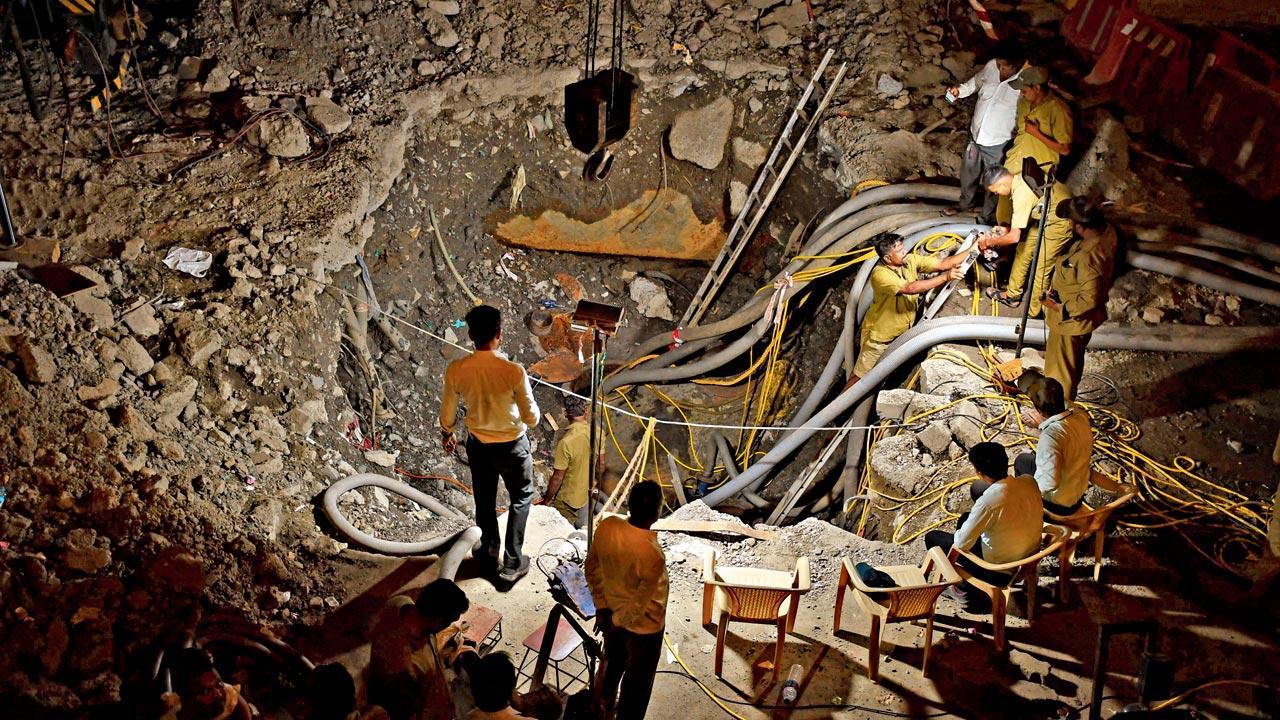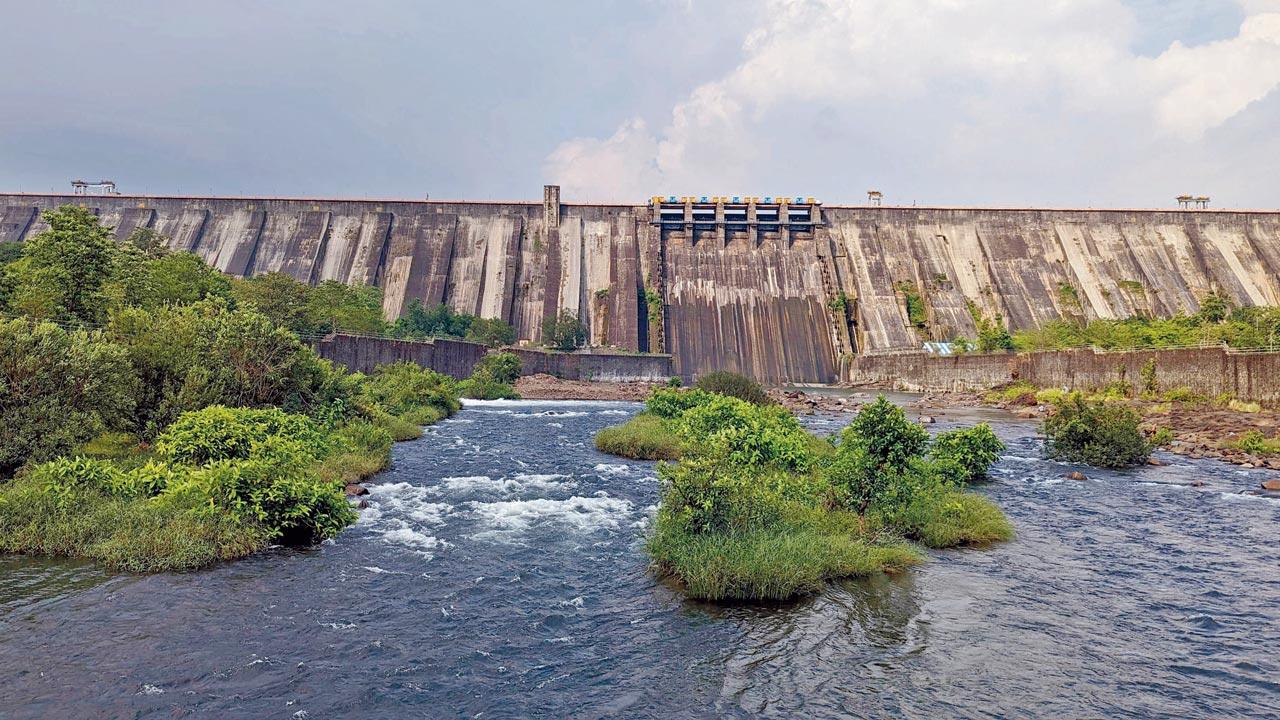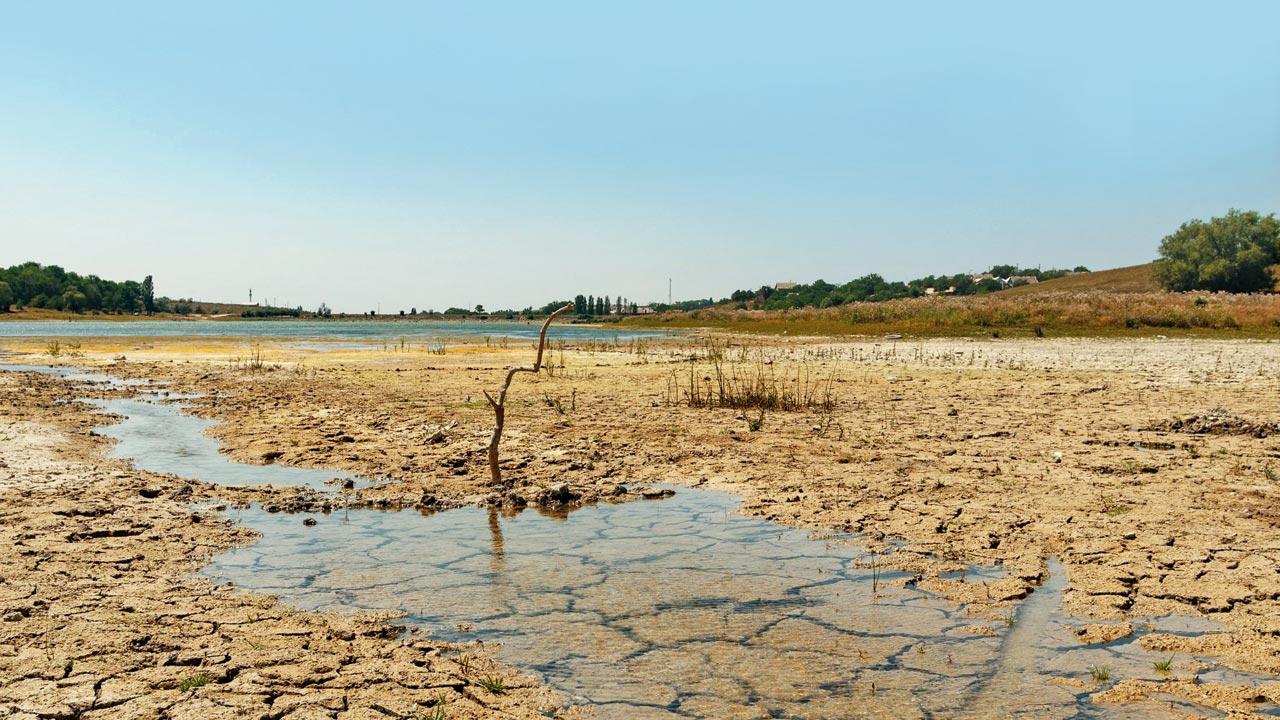Civic data shows that leakages, illegal connections, and theft account for around 1,100 million litres per day, which comes to 30 per cent of daily requirement

BMC workers plugging a leak in the 1,450-mm-diameter Tansa pipeline in Dadar on May 28, 2023. The repair work had affected the water supply to the G South and North wards. Pic/Ashish Raje
Key Highlights
- BMC hasn’t taken any firm steps to improve its water stock
- For the third consecutive year, the BMC has imposed water cuts due to delayed monsoon
- Water crisis has become new normal for city despite ‘normal rain’ during monsoon season
Is Mumbai heading in the same direction as Bengaluru and Delhi, which have been facing severe water crises with dams drying up? Despite Maximum City experiencing serious water issues for the past 10 years, the Brihanmumbai Municipal Corporation (BMC) hasn’t taken any firm steps to improve its water stock. For the third consecutive year, the BMC has imposed water cuts due to the delayed monsoon. This has happened every year—except for two—in the past decade.
Projects such as the Gargai dam or desalination plant at Manori, which have been discussed for over a decade, have seen no progress. Also, the amount of water that is unaccounted for is a whopping 30 per cent of the total supply to the city—more than the daily amount supplied by a large dam.
ADVERTISEMENT
With water levels touching a new low and delayed monsoon, the water crisis has become the new normal for the city despite ‘normal rain’ during monsoon season. The situation will remain the same for at least the next five years as no water projects are anticipated to be completed till then.
Currently, the city receives 3,850 MLD (million litres per day) of water from seven lakes against the requirement of at least 4,500 MLD, which could possibly rise to 5,000 MLD in the next five years. To match the demand-supply ratio, the desalination project at Manori, which can add 200 MLD of water after three years, will help to some extent. The project’s 200 MLD capacity can be later expanded to 400 MLD. In addition, the BMC revised a plan to construct a Gargai dam in the Tansa sanctuary which can add 440 MLD of water to the city’s supply. But both projects are in limbo.
 The Bhatsa dam near Shahapur in Thane district on June 15. Pic/Ranjeet Jadhav
The Bhatsa dam near Shahapur in Thane district on June 15. Pic/Ranjeet Jadhav
Gargai dam
The most recently constructed reservoir, the Middle Vaitarna dam, was built and commissioned in March 2014. The construction work on the dam began in October 2008. Though the BMC has been working on the Gargai dam for the past decade, nothing much happened on that front. The project needs an environmental clearance from the Centre’s Forest Advisory Committee (FAC) and the National Wildlife Board. “But before that, the proposal has to get a nod from the state forest department. We recently sent a letter to the forest department to complete a procedure to hand over 650 hectares of land in Chandrapur district for compensatory afforestation. The afforestation has to be started to get permission,” said a senior BMC official. The process of getting permission has been going on for five years, but there has been no progress. Besides, the BMC also surveyed villages that need to be rehabilitated. “We are ready to do all the required processes, but we do not have control over the speed of other departments, so we cannot say when we will get all the necessary permissions,” said the official.
Desalination plant
The BMC in February 2021 appointed an Israeli company to prepare a detailed proposal for the Manori project. In January 2022, the corporation engaged SMEC India to evaluate the study and designs prepared by the Israeli firm. The civic body issued a tender notice on December 4, 2023, to set up a plant which can turn saline water potable. The deadline for submitting tenders was January 4, 2024, but the BMC extended it at least seven times and now the new deadline is June 27, 2024. “This is the first project of its kind and we have been working on many new things. International bidders want clarifications on many issues, so it is time-consuming,” said a civic officer attached to water projects.
Giving a work order will take another six months even after receiving tenders. The project will take at least four years to be completed. The estimated cost of the project is Rs 3,520 crore. Apart from construction, heavy expenses are likely to be incurred for electricity, maintenance and asset replacement. It is estimated that over 20 years, the project will cost Rs 8,500 crore.
Missing 30 per cent
In general, around 25 per cent of the total water supply in the commercial capital is unmetered or unaccounted for due to leakages, unauthorised connections, water theft and metering inaccuracies. Ideally, the loss percentage should not be more than 15 per cent of the total supply. But currently, the unaccounted water is 30 per cent, which is also due to a high evaporation rate, said a senior official from the BMC. It is a huge number considering the amount of daily supply. The city received 3850 MLD. This means almost 1,100 MLD is missing. Even if the BMC managed to reduce the unmetered water to 15 per cent, then almost 550 ml of water would be saved.
As per records, the civic body recorded 20 per cent non-revenue water (NRW) in 2009. With the help of digitisation and GPS, the aim was to reduce water loss to 15 per cent. Fifteen years later, the BMC is still fighting the menace while the percentage of water loss has jumped by 10 per cent. “The problem lies with old pipelines, continuous leakages undetected leakages and delays in carrying out repairs. There is also a major issue with pumping out water unauthenticately,” said
an official.
What is today’s situation?
The water stock of seven lakes supplying water to the city is 5.38 per cent of their total capacity. This is the lowest stock in the past three years. Last year, the city lakes had 8.48 per cent of stock whereas in 2022, the stock was 11.49 per cent.
After receiving permission from the state government, the BMC started fetching reserved quota from the Upper Vaitarna and Bhatsa. As on June 17, the city used 30,767 million litres of reserved water from 91,130 million-litre quota of Upper Vaitarna and 11,848 ml water from the 1,37,000-million-litre carryover contention of Bhatsa.
BMC chief speaks
“We have been working on a desalination project, but it is going to provide only 200 MLD of water, which is way below our requirement. Currently, we are pushing the Gargai dam project, which needs environmental clearance. But we focused on it and will try to clear it as soon as possible. The other two dams are not on the priority list as of now,” said Municipal Administrator Bhushan Gagrani. He added that, unlike Delhi or Bengaluru, the city gets good rainfall and “we are never short of potable water”.
3,850 MLD
Amount of water received by city from seven lakes
Rs 3,520 cr
Estimated cost of Manori desalination plant
Shortages and water cuts since 2014
2024 The BMC imposed a 5 per cent water cut from May 30, when the water stock dipped below 10 per cent and a 10 per cent cut from June 5
2023 Even after using the reserved stock of lakes, the stock was less than seven per cent in June. As the rain was delayed, the BMC imposed a 10 per cent cut from July 1 till August 2
2022 10 per cent water cut from June 28 to July 12, as stock dipped to 9 per cent
2020 10 per water cut was imposed from August 5 to 29 due to poor rainfall
2018-2019 10 per cent water cut from November 14, 2018, to July 2019
2015-2016 20 per cent water cut was imposed in July and lasted until the next monsoon
2014 20 per cent water cut from July to September
What’s the issue in Bengaluru and Delhi?

Bengaluru faced a shortage of 500 million litres of water every day in March, which was about a fifth of the city’s daily total demand. Due to the severe water shortage, the metro city witnessed its driest April in 41 years in 2024. It was an election issue too. The situation isn’t normalised yet due to the delayed and weak monsoon. Delhi’s water supply plunged to its lowest this season—a 10 per cent shortfall from the targeted supply—aggravating nearly a fortnight-long crisis. The AAP-led Delhi government has blamed Haryana for the raw water supply shortfall, an allegation the latter’s government has refuted, saying the Delhi government was trying to hide ‘its failures’.
Ample water storage and continuous supply of water was the USP of Mumbai. The city was ahead of other big cities in the planning of new projects to improve water stock in accordance with daily needs. As per a projected population of 17.24 million in 2041, a 40 per cent increase from 2011, the corporation had planned to cater to a water demand of 5,940 MLD. To address the shortfall, BMC planned the Gargai dam (440 MLD), Pinjal dam (865 MLD) and the Damanganga-Pinjal River link (1,586 MLD) by 2040, boosting water storage by 2,891 MLD. In addition, a desalination plant which was projected as environmentally friendly was planned to create an additional supply of 400 MLD.
 Subscribe today by clicking the link and stay updated with the latest news!" Click here!
Subscribe today by clicking the link and stay updated with the latest news!" Click here!








